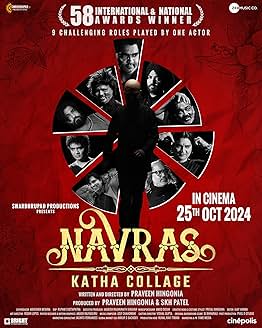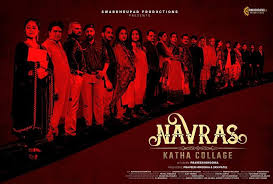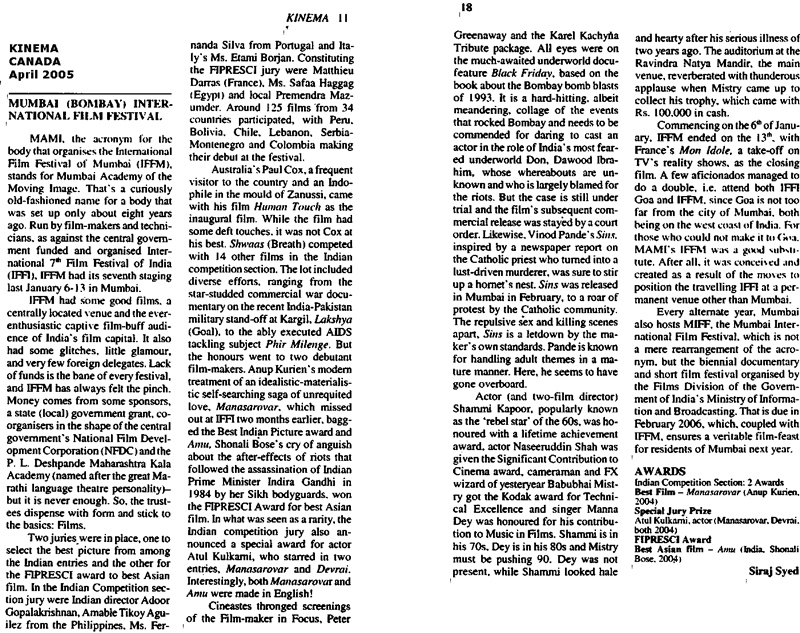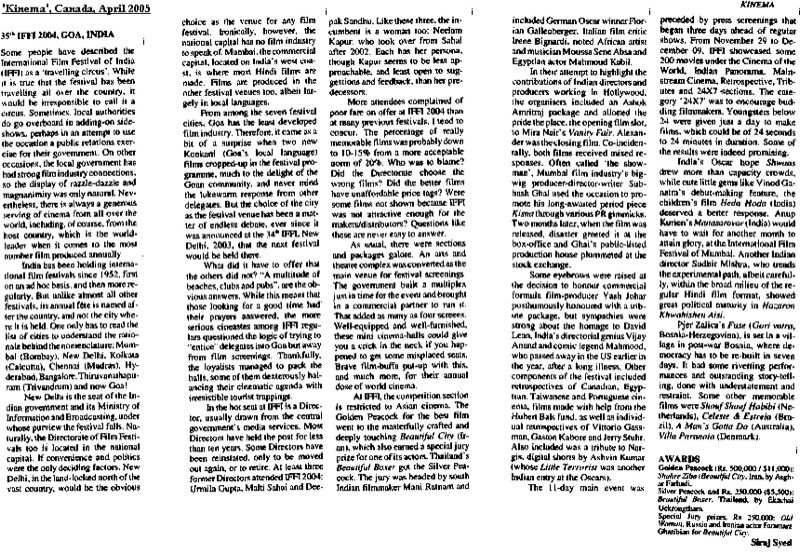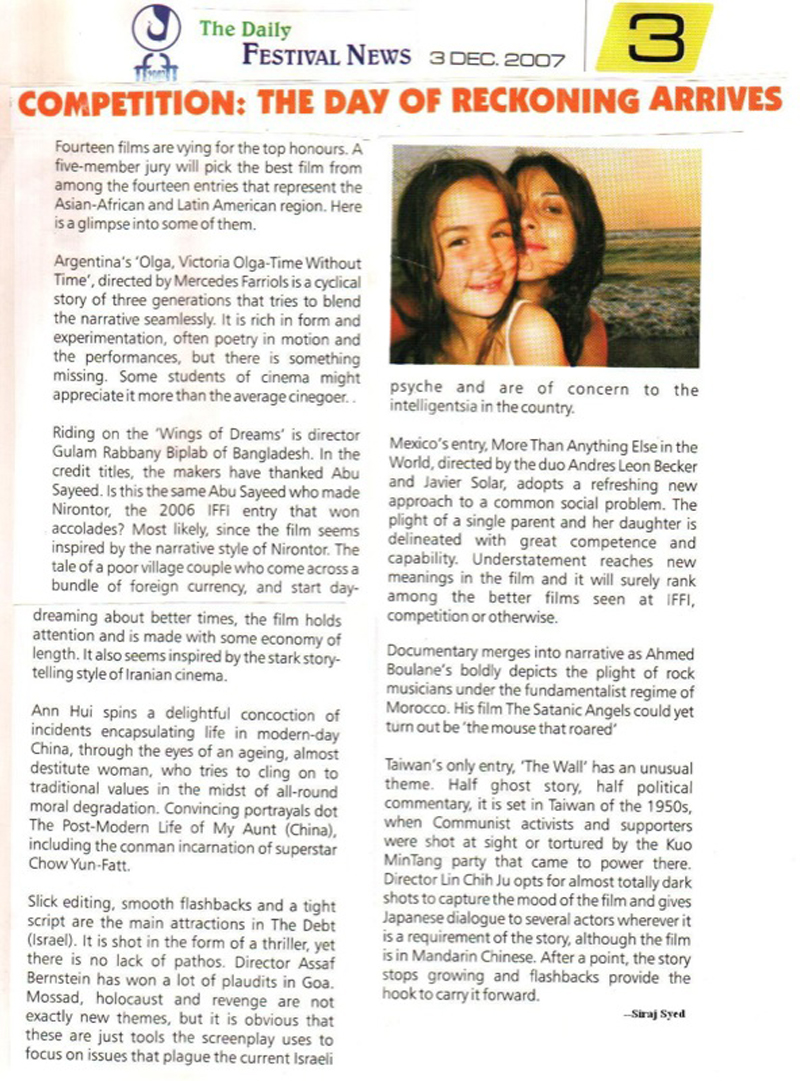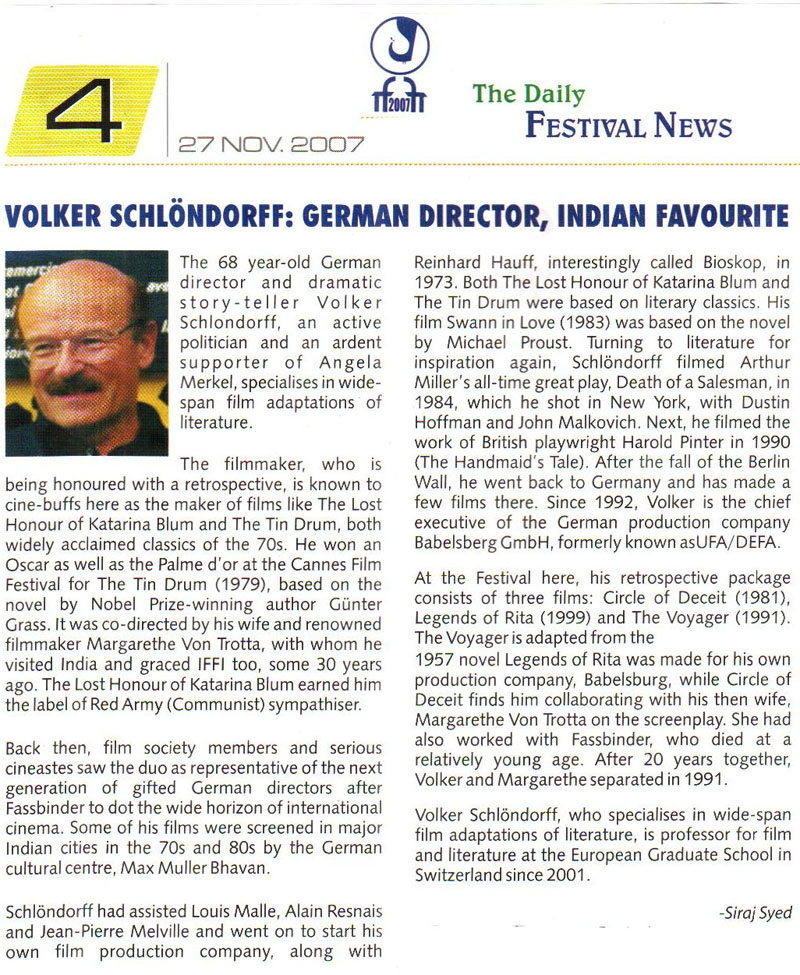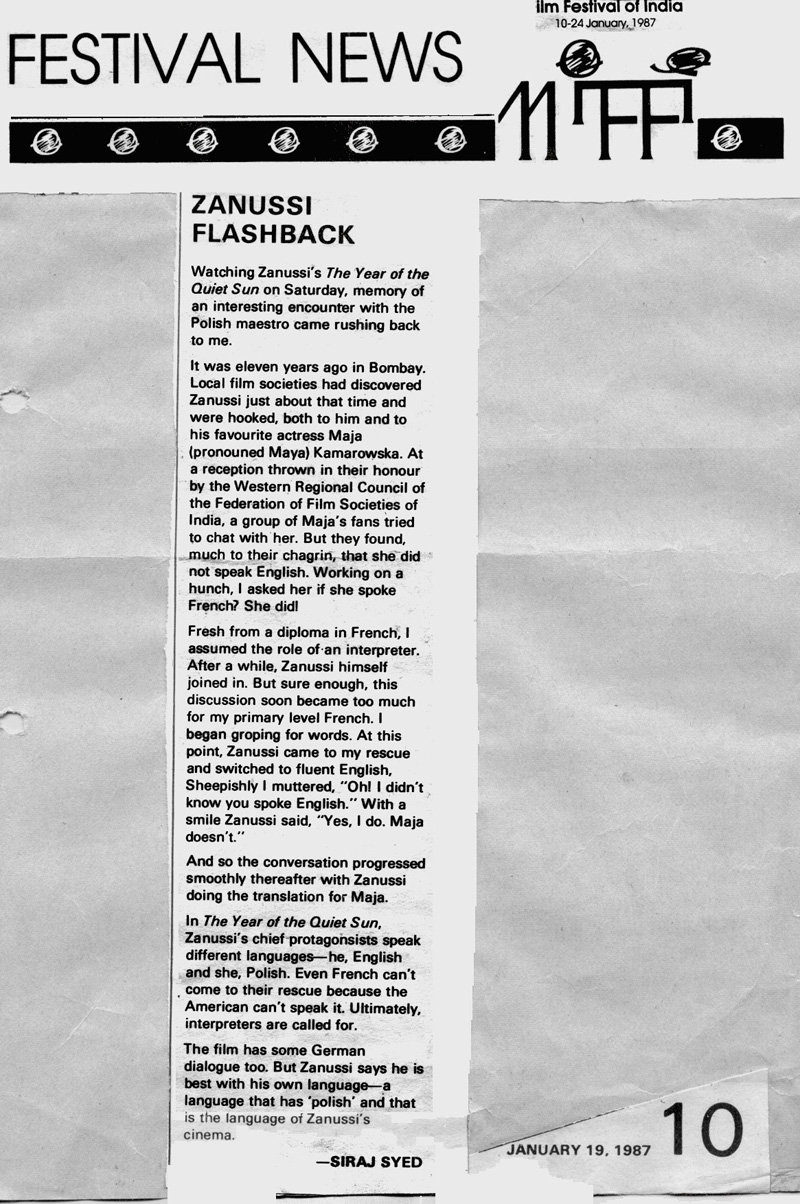|
|
||
|
Pro Tools
FILMFESTIVALS | 24/7 world wide coverageWelcome ! Enjoy the best of both worlds: Film & Festival News, exploring the best of the film festivals community. Launched in 1995, relentlessly connecting films to festivals, documenting and promoting festivals worldwide. Working on an upgrade soon. For collaboration, editorial contributions, or publicity, please send us an email here. User login |
Katha Collage, Review: It might get a few ‘awards’, for….
Katha Collage, Review: It might get a few ‘awards’, for…. Comedian Jerry Lewis, in the top league during the 50s and 60s, made a breakthrough movie in 1965, called The Family Jewels. Breakthrough, because he played seven roles in the film, all brothers, besides co-writing and directing it. I have been unlucky not to have seen this reportedly hilarious experiment, but I came close when I saw an Indian, Hindustani film, Naya Din, Nayi Raat (NDNR). Nine years after The Family Jewels, 1n 1974, Sanjeev Kumar, one of our greatest ever actors, took on the task of playing not seven, not eight, but nine roles in this film, directed by A. Bhimsingh, from down South. Essaying the Nava Rasas (the nine moods or rasas of ancient Indian dance and drama), he was dynamite. Unfortunately, the film was no cracker at the box office. But it was the only film in which Dilip Kumar, arguably the greatest actor of his time, gave his voice-over in the opening, lauding the brilliance of Sanjeev. I found out much later that (NDNR was a remake of a 1964 Tamil film starring Sivaji Ganesan, the Tamil titan, written, produced and directed by A. P. Nagarajan. BhimSingh wrote the screenplay for the Hindustani version. Guess what? India pre-empted Hollywood by a whole year! Or did good old Jerry get inspired by the Tamil original, which got mixed reviews? NDNR also got mixed reviews and failed at the box office. Cut to 2024. A man named Pravin Hingonia makes a film, playing multiple (none, to be exact) roles as well as writing and directing it, and doing the choreography. He calls it a curious Navrasas Katha Collage, a moniker that will be Sanskrit and Latin to 90% of Indians. His film is far removed in terms of story or concept from the above-mentioned two movies. If they were experimental, Collage is detrimental. If they were cohesive, Collage is ‘anthesive’, if they boasted of a lead actor who could pour life into any role, Hingonia, as actor, pours roles into any life, if NDNR failed because Sanjeev, the actor par excellence, had no mass following, and the supporting cast was perfunctory, except for the just blooming Jaya Bhaduri, Collage has an actor nobody has heard of and a supporting cast that few will support. If Navarathri, The Family Jewels and Naya Din Nayi Raat were the handiwork one director each, Collage is a directed by a ‘college’ called Pravin Hingonia, with most students in the first year. The nine rasas, and nine sub-titles, as interpreted in the writer-director’s own imagination and actualisation, come out as obfuscation and usurpation. With the Ramayana and the Mahabharata being the source of endless movie adaptations and inspirations, why should we not delve into the nineRs, at least in the golden jubilee year of Naya Din Nayi Raat? A manuscript lands in the office of a talent agency. It is called…no marks for guessing…Katha Collage. And the collage then begins with the dramatisation of its first story, that of a lion-hearted hijra (eunuch). One large-hearted hijra who adopts a girl, raises her, and arranges for her marriage, only to get cheated by the suitor, who decamps to Dubai. When he doesn’t return for ‘karvaa chouth’, a Hindu ritual involving fasting and sighting of the moon, in the presence of the husband, questions arise. It is discovered that the husband is marrying another girl in Dubai. While the Indian bride takes this philosophically, even insisting that she will go to Dubai and dance at her husband’s second wedding, the hijra is heart-broken, collects Rs. 30,000 for her, hands the money over, applies the bindi (the forehead dot) on the girl and falls dead. This same hijra actor (try and guess who it could be?)returns in all the following roles, but in different characters: an auto driver, a man who does not believe in marriage but insists that true love can only be found outside marriage, a father whose son has saved his father’s number under the name Hmmm, after his father’s ‘hmmmming’ habit, a struggling actor with a walking defect who manages to reach a well-known actor and narrates his own sob story even as the actor is getting his make-up put on story, an unfaithful husband who gets found out and faces a suicidal wife, a rapist who, along with four others, rapes a school-girl after their bus gives her a lift, a Women’s Helpline phone operator who is herself the victim of domestic violence…Have I listed nine? No, I am not counting. Digging out info on Pravin Hingonia, I learn that he has wrote THE RAGE: Over Injustice, on LGBTQ and ‘Women Empowering’ and The Creator: Jay Sarjanhar (2023), A man on the mission to change the world, which he has both written and directed. He also acts, along with Arya Babbar and Shaji Chudhury. Besides films, there is a TV serial to his writing credit, called Games of Karma. As a viewer, I have a lot of rage over the injustice perpetrated by Collage and if Pravin is a man on a mission to change the prose, poetry and grammar of cinema, one can say that he has taken a bold step. Maybe following generations of film-makers might find something revolutionary in his art of story-telling, but with Navras Katha Collage, one can only see him blazing a new path, but blundering and plundering along the way. These are all Games of Karma. In between the visual mayhem, Pravin manages to squeeze in a delicate short story about a couple who love each other madly, and yet want to get divorced the day after their marriage. It takes some believing that this episode was written, directed and enacted by the same man who made such a mess of all the other tales. Oh yes! I understand. He wanted to show what a vast range of subjects—from the taboo to the surreal to the realistic—he can tackle. But in the process, he has gone not only overboard but ensured that is audience is over-bored. I didn’t time the newly married couple episode, but assuming it is 16 minutes long, he should salvage it as an independent film and exploit is accordingly. The rest of the 2 hours and 7 minutes require supreme will-power to sit through. And one tip that might help the film get an extra star is the complete deletion of the sound track. No music at all. As it stands, some audiences are likely to need hearing aids after sitting through Collage.
Whenever the scene makes sense (some actually do), all the artistes have given a good account of themselves. But all the shouting, yelling, hollering, screaming, wailing (thesaurus, anyone?) brings out the worst in them. You can take one outburst from an actor. Perhaps two. Okay, three. But not 30. Moreover, there seems to have been a hell of a lot of improvisation in dialogue, with many words coming from empty mouths and many pairs of silent lips intonating audible words. Could these not have been corrected at the dubbing stage? Very often, actors look in one direction, and keep looking, as if the director has forgotten to say cut. Reasonable talented, Sheeba Chaddha, as the boss of the talent hunt agency, is the worst victim of this syndrome. She must have spent a full six minutes on the screen, saying nothing, doing nothing and looking nowhere. Alka Amin cries her heart out, and out and out.
Names that figure in the supporting cast include Dayanad Shetty as a foreign Army head who orders the relentless torture of the captured Indian spy, Ram Awana, Shaji Chaudhary, Dolphin Dubey, Swar Hingonia, Amardeep Jha, Shriya Jha, Alka Badola Kaushal, Ruhana Khanna, Jashan Singh Kohli, Neelu Kohli, Bhuvnesh Mann, Revathi Pillai, Gyan Prakash, Krishna Raaz and Sunita Rajwar. Ruhana and Swar are also the names of characters in the film. In a Special Appearance, Rajesh Sharma, tries his best to suppress the unintentional humour that dots the struggler’s monologue by Hingonia. And alas, the end of the scene, which needed have been extremely well-written, has no heart in it. Of his four roles, as writer, co-producer, choreographer and actor, one can only find a few good words to say about the last two aspects. Choreography is passable. Maybe he has done theatre, which is where the ability to deliver long monologues is harnessed. He is good when he is in normal situations. As soon as the chronicles go awry, he seems to lose all sense of proportion, something that was completely avoidable, which inflicted upon us via his supporting cast too made his actors emulate. To his credit, almost all smaller parts are given due prominence, and he does not hog the camera. Obviously, with nine roles, he does not need to. One thing has helped the film: its visuals and locales. The ambience is usually just right for the theme, though the narrative takes away all the pleasure. Art department is not credited, and maybe there wasn’t any, so the credit should be divided between cinematographer Rupam Chetiapatra and Kunal Ravi Tiwari (VFX). But Chetiapatra is also responsible, equally with Hingonia, for the unbelievably jerky visuals and painfully obtuse angles, as much as the VFX department. Shots repeated at breakneck pace ad nauseam, ad infinitum, some with exactly the same frames and dialogue, some with partly different stuff and some with entirely different material. Editor Ajay Varma is a partner in this crime, of changing perspectives and narration, to different points of view. Rashomon (Japan, Akira Kurosawa), the pioneer of this form, must have been on Pravin’s watch list before he embarked upon Navras Katha Collage.
Perhaps the greatest disservice the film does is to its music department, headed by Asif Chandwani, and comprising (according to the listing on imdb) Munawwar Ali ... Singer Salim Begana ... Lyrics Farhad Bhiwandiwala ... Singer Abhijeet Gadwe ... Programmer Praveen Hingonia ... Songs Choreographer Priyal Hingonia ... Singer Shaitus Joseph ... Mixing Priti Kshirsagar ... Lyrics Suchir Kulkarni ... Programmer Harry Maliya ... Lyrics Harmaan Nazim ... Singer Some really tuneful and soulful songs are enmeshed into sound effects, and the entire soundtrack plays at 1,000 decibels. I wonder if it was the release print that we were shown, but if it was, “Friends, Romans, countrymen, DO NOT lend it your ears.” All said, Navras Katha Collage might bag awards for The Most experimental film of the millenniumThe loudest soundtrack ever recorded in movie historyThe maximum amount of shouting, yelling, hollering, screaming, wailingThe maximum time for which actors look at an angle to the camera and say or do nothingThe only film in which four souls (dead young men), in heaven, hell or in between, can obtain a luxury busto transport a fifth soul, the victim of these four and a fifth, to a destination which is no destination and offer her chips along the wayThe only film in which a farmer receives an appointment letter for getting recruited in a country’s secret service while toiling in the middle of his farm, and not at his home, and runs about two kilometres shouting his mother’s name, while Mom is back home.
27.10.2024 | Siraj Syed's blog Cat. : Pravin Hingonia Rajesh Sharma Sheeba Chadhha
|
LinksThe Bulletin Board > The Bulletin Board Blog Following News Interview with EFM (Berlin) Director
Interview with IFTA Chairman (AFM)
Interview with Cannes Marche du Film Director
Filmfestivals.com dailies live coverage from > Live from India
Useful links for the indies: > Big files transfer
+ SUBSCRIBE to the weekly Newsletter Deals+ Special offers and discounts from filmfestivals.com Selected fun offers
> Bonus Casino
User imagesAbout Siraj Syed Syed Siraj Syed Siraj (Siraj Associates) Siraj Syed is a film-critic since 1970 and a Former President of the Freelance Film Journalists' Combine of India.He is the India Correspondent of FilmFestivals.com and a member of FIPRESCI, the international Federation of Film Critics, Munich, GermanySiraj Syed has contributed over 1,015 articles on cinema, international film festivals, conventions, exhibitions, etc., most recently, at IFFI (Goa), MIFF (Mumbai), MFF/MAMI (Mumbai) and CommunicAsia (Singapore). He often edits film festival daily bulletins.He is also an actor and a dubbing artiste. Further, he has been teaching media, acting and dubbing at over 30 institutes in India and Singapore, since 1984.View my profile Send me a message The EditorUser contributions |

















